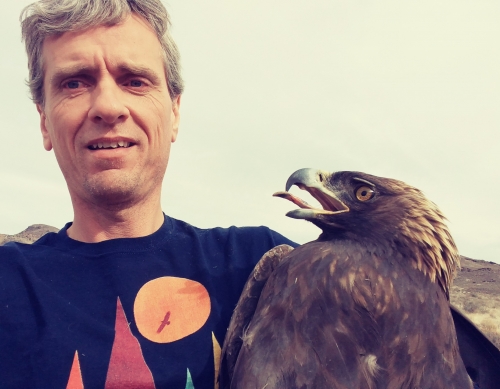Conservation Science Director
HawkWatch International
Bio:
Steve joined HawkWatch International (HWI) in June 2006 as the organization’s Conservation Scientist and has since become the Conservation Science Director. Much of Steve’s recent work has focused on Golden Eagles, including monitoring, transmitter deployment and tracking, and risk assessments. Steve has also served as a principal investigator in research on the impacts of invasive cheatgrass, fire, and prey declines on West Desert (Utah) Golden Eagles, Ferruginous Hawks, and Burrowing Owls. He has overseen research on the potential risks of proposed wind developments to local, migratory, and wintering Golden Eagles, the potential impacts of oil and gas development on nesting raptors in Utah and Wyoming, and the ability of perch-deterrent devices to exclude raptor power line perch use in Southwestern Wyoming. Steve has also been involved in HawkWatch's long-term nesting and migration surveys. His work also focuses on identifying current and emerging threats to raptors, information needs, potential future research projects, and translating raptor science into conservation action. Currently, Steve serves on Utah’s Bureau of Land Management Resource Advisory Council and as the facilitator for the Utah Eagle Working Group. Before joining HawkWatch, he spent 6 years in Wyoming, where he obtained his master’s and doctoral degrees in Zoology and Physiology from the University of Wyoming. His master’s thesis was on greater sage-grouse use of prescribed and wild burns and was completed in 2003. Steve obtained his Ph.D. in 2006 and wrote his dissertation on issues of scale and bird community responses to riparian cottonwood declines, Russian-olive invasion, and landscape alteration. Steve has had a life-long interest in birds and wildlife of all kinds and enjoys being outdoors with his wife and three young boys while hiking, mountain biking, camping, and wildlife watching.
Title: The Importance of the Great Salt Lake and Promontory Peninsula to Raptor Populations
Friday, May 11th, 9:40 AM
Abstract: The Great Salt Lake ecosystem encompasses a unique landscape of wetlands, grasslands, shrublands, and agricultural habitats that provide critical breeding, wintering, and migratory habitat for hundreds of bird species. Birds of prey are located at the apex of most avian food chains, and can thus reflect the health of ecosystems such as the Great Salt Lake. The Promontory Peninsula-area of the Great Salt Lake ecosystem is one such important region for raptor populations that utilize the area year-round. Golden Eagles, Red-tailed Hawks, Swainson’s Hawks, American Kestrels, Peregrine Falcons, Great Horned Owls, Short-eared Owls, and Burrowing Owls breed along the peninsula. Three of these species – Golden Eagle, Peregrine Falcon, and Burrowing Owl – are Species of Greatest Conservation Need in Utah. Two other Species of Greatest Conservation Need – Bald Eagle and Ferruginous Hawk – utilize the peninsula during migration and winter. The east Promontory Road and 7200 N are also known hotspots for raptor-vehicle collisions, a mortality risk that could become significantly exacerbated with increased vehicle traffic. Road strikes from at least five raptor species have been documented along these two roads with very little survey effort; including Short-eared Owl (n = 5), Burrowing Owl (n = 3), Golden Eagle (n = 1), Turkey Vulture (n = 1), and Red-tailed Hawk (unknown number). HawkWatch has conducted migration surveys near Promontory Point and Antelope Island that confirm the importance of the area to spring and fall raptor passage. Finally, recent Golden Eagle tracking data from multiple individuals also highlights the importance of the general area and traffic route for foraging eagles.

